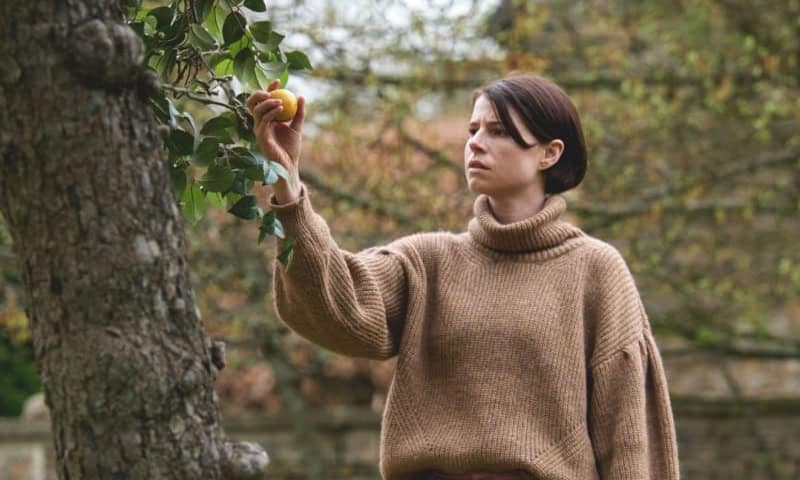‘Men’ Features Jessie Buckley At Her Best
Girl meets boy. Girl meets other boy. Girl meets still other boy. The nightmare continues.

Months after her deservedly-celebrated work in The Lost Daughter, Jessie Buckley returns to the big screen with one of the year’s richest performances in Men, a 100-minute horror film from writer-director Alex Garland (Ex Machina; Annihilation). Buckley plays Harper, a young woman on a solitary vacation to the English countryside. The viewer soon learns the circumstances of Harper’s sojourn through a series of flashbacks: her husband James (Paapa Essiedu) threatened to kill himself after Harper insisted on a divorce, subjected her to physical and emotional abuse, and eventually did fall to his death from the top of their apartment building. Whether it was an accident or suicide, no one knows for sure.
Harper’s time in town should be a relaxing getaway; a time to reflect and deal with the trauma left by such events. But naturally, things do not go as planned. This is where the men — and the horror — come in.
Men marks a departure from Garland’s characteristically cerebral style. There are certainly lots of big ideas. Yet the film has a more visceral, physical feel. Fittingly, so much of the film’s themes and visual style concern the body.
Both come to a head in the work of Rory Kinnear. Billed as Geoffrey, the owner of the luxury home Harper rents in the country, Kinnear actually plays each of the men Harper meets in town: the bartender, a police officer, a clergyman, etc. All share the same face, yet Kinnear slips in and out of these characters with such apparent skill, it is easy to forget the visual resemblance on which the film directs us to dwell.
Viewers with weaker stomachs should be aware of the film’s body horror before watching, but these moments are few and far between, and not overly gratuitous. And they are only one kind of horror Garland and cinematographer Rob Hardy bring to the screen. Some of the film’s most horrific moments come just from “ordinary” exchanges. Kinnear’s men find new ways to blame Harper for the abuse she has endured. They attempt to convince her to not believe what she sees and experiences, and she faces greater danger as a result.
The filmmakers’ respect for genre comes through in a number of the usual visual cues: bathtubs, apples, and abundant religious iconography. The basic structure of the story (a woman trapped mostly in a house, facing an outside threat) is one we have seen before, but Garland takes a number of visual and narrative risks that make the film his own. Most work, but even those that do not deserve appreciation.
Garland shows a healthy disregard for explaining the machinations of the story world. We do not know whether these men are some sort of supernatural phenomenon or an imagined (partially or otherwise) byproduct of Harper’s trauma. What matters is that it is all real to her.
Harper’s one ally in the film is the only other woman, her friend Riley (played by Gayle Rankin), who she regularly FaceTimes. The conversations and Riley’s virtual presence bring comfort to Harper, at least until things really start to go down. Riley’s absence ties back to the film’s larger thematic exploration of the body and physicality, and in particular the ways that technology changes our understanding of what it means to be present.
Buckley’s Harper is vulnerable, honest, and contemplative. When the men act insane, she calls out their shit, and by the film’s end, the source of the horror becomes a force that she controls. Still, though, no discussion of the film would be complete without mentioning its humor. A number of funny lines often diffuse the haunting atmosphere of the countryside town. Such moments also show the ways in which Garland has command over the tone of this film. Because (thankfully) little dialogue is given to over-explanation, the film becomes more about mood; a series of looming physical threats and psychological struggles to be endured.
Many key moments in Men are shot in textured darkness, the kind that looks especially good on the big screen. The film’s sound design often foregrounds silence. Concise dialogue and exceptional music by Geoff Barrow and Ben Salisbury bring an immersive quality to the film that allows for full identification with Harper, who is on screen for nearly every minute.
The film clearly fits well into the folk horror tradition. It bears traces of the visual style and narrative approach that has made filmmakers like Ari Aster and Robert Eggers so popular today, but there’s enough in Men for fans of all horror and psychosocial thriller traditions to be satisfied.
Buckley and Kinnear are as captivating a duo as one can find. His mesmerizing work is the glue that holds the film together. Buckley, from the moment Harper eats an apple in Geoffrey’s garden at the outset of the film, elevates the work from a well-made horror flick to a reimagining of the evergreen story of men and their treatment of women. What could be more horrific than that?
Men will be released in theaters on May 20, 2022, in the United States.
